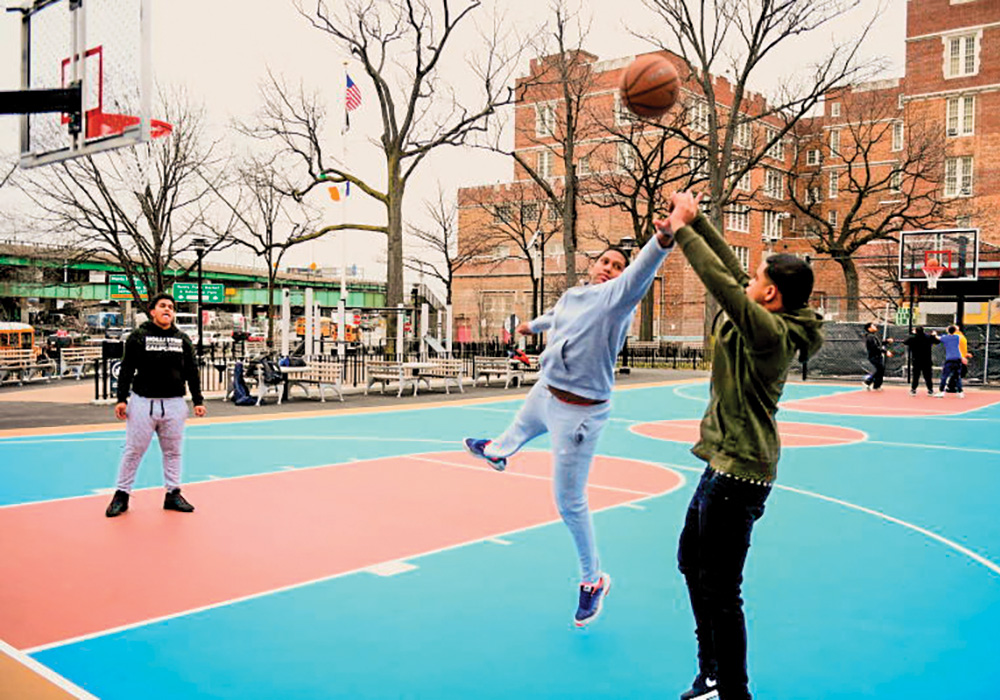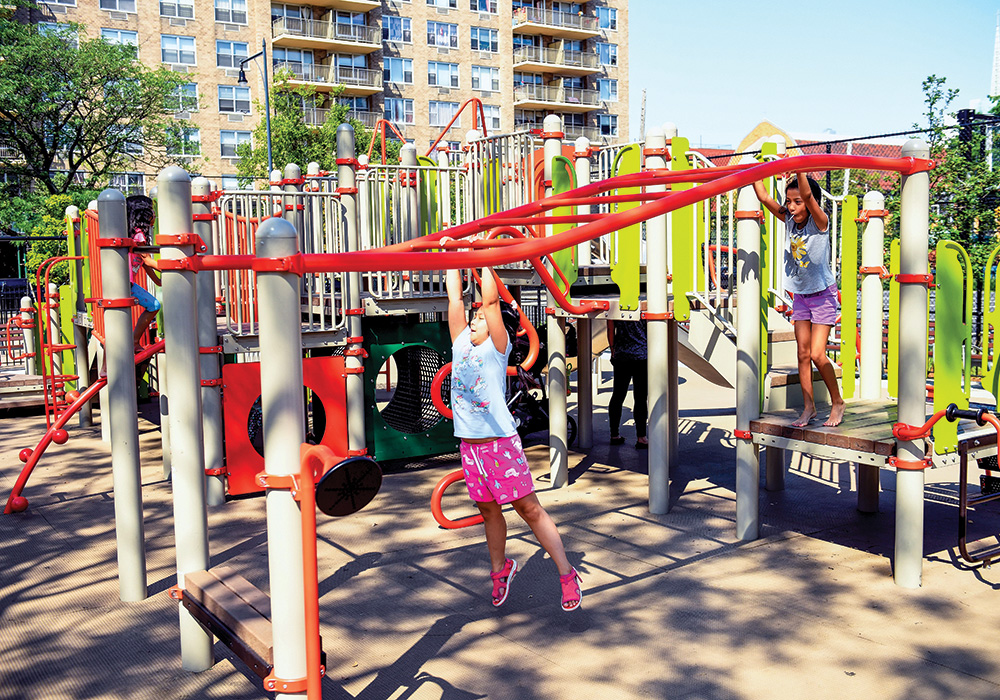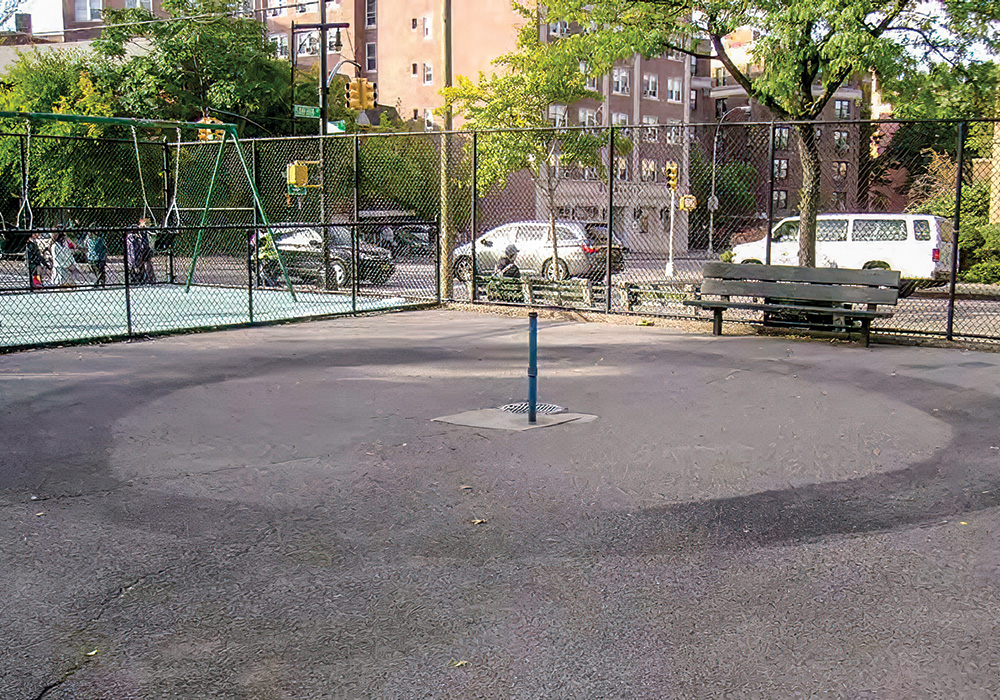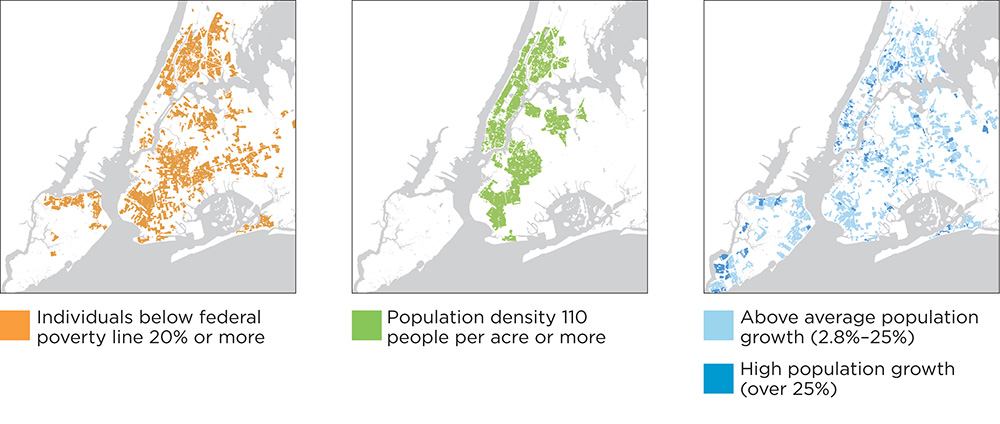Planning May 2020
National Planning Excellence Award for Advancing Diversity & Social Change in Honor of Paul Davidoff
An Equitable Parks Plan Driven by Data
New York City’s Community Parks Initiative | New York, New York


Community members were active participants in the design phase of the renovated Lyons Square Playground. Photos by Malcolm Pinckney, NYC Parks.
By Marya Morris, FAICP
Anita Reyes was born in the early 1970s, the oldest child of immigrants from the Dominican Republic. "We lived in the Morrisania section of the South Bronx, a rough neighborhood if ever there was one," she says.
Lyons Square Playground is at the center of the Morrisania neighborhood, where 98 percent of residents are minorities and 37.7 percent of households live in poverty.
As a child Reyes remembers Lyons Square Playground as a place with broken equipment, basketball courts with no rims on the backboards, and the paint worn off the court surfaces. It was essentially a 1.32-acre slab of pavement. "Still, it was our patio, our backyard. My family was four kids and two parents living in a two-bedroom apartment," says Reyes. "That park was all we had."
In 2014, Lyons Square Playground was one of 67 parks identified by the NYC Department of Parks and Recreation (NYC Parks) for its Community Parks Initiative — a $318 million (and counting), equity-focused and data-driven effort toward fairer distribution of public parks and recreation funding citywide.
Fair Play
The Community Parks Initiative's investment has improved about 70 acres of parkland in neighborhoods with the highest need. The community impacts extend beyond the renovations.
55 of 67 CPI sites have community partners cultivated by NYC Parks, and partners are being developed at its remaining sites.
300+ community partners have been supported by NYC Parks staff.
54,000+ volunteers took part in more than 2,000 stewardship projects; CPI awarded $280,000 for community-led programs.
400+ seasonal playground associates hired by NYC Parks provide youth sports and recreation programming; 1.9 million young people have participated in the free programs
A different approach
Launched in conjunction with NYC Parks' affiliated nonprofit, Partnership for Parks (part of the City Parks Foundation), the program stands out from previous parks investment efforts by New York City because it introduced new data-driven prioritizing criteria for selecting parks to receive public funding.
Nicholas Molinari, AICP, chief of planning and neighborhood development for NYC Parks, says, "CPI is unique in that NYC Parks was able to use data to guide a large mayoral investment to sites across the city that had not received investment in 20 years, in communities with the most need."
Equity-Driven Park Investment
To ensure equitable distribution of resources through the Community Parks Initiative, NYC Parks pioneered a new data-driven methodology to prioritize smaller community parks that needed the most help. It analyzed capital investment and demographic data (below) and identified 67 community parks within 55 CPI zones, where they are focusing capital investments and community outreach efforts to improve park access, quality, amenities, and maintenance.

Source: NYC Parks: Framework for an Equitable Future
The usual process for park investment is for city council members and borough presidents — who have discretionary funds for all types of capital projects (including park improvements) in their districts — to decide which parks will receive funding. Neighborhood groups and parks conservancies submit proposals for capital projects to these elected officials every year. Over time parks in neighborhoods with active constituencies have received disproportionately more funding than parks in neighborhoods without such groups, including the Lyons Square Playground.
That dynamic, compounded by the inability of the city to fund all park needs at every site, led to the inequitable and sustained lack of investment.

Bowne Park in downtown Flushing, Queens, as it looks now. The playground reopened in August 2019 and has new play equipment, swings, basketball and handball courts, and new landscaping, as well as green infrastructure improvements. Photo courtesy NYC Parks.

Browne Park in downtown Flushing, Queens, before its renovation. Photo courtesy NYC Parks.
Wanting to take an equity-based approach to funding allocation, the NYC Parks team derived CPI's criteria by using the city planning department's Neighborhood Tabulation Area boundaries as the basic geographic area. They overlaid demographic data to identify areas with high density and ongoing population growth, and where 20 percent or more of households live in poverty. More than 200 parks with a combined capital need of greater than $1 billion emerged from that initial analysis. Qualitative research of each of the parks, in the form of site visits and public listening sessions, followed the data crunching.
Eventually 67 community parks, many just one block in size, were chosen to receive CPI funding, including Lyons Square Playground — Anita Reyes's "backyard."
Criteria Used to Identify Parks With Greatest Investment Need
Through mapping exercises, NYC parks found 54 percent of the city's 200-plus underresourced parks directly served U.S. Census tracts with above-average poverty, and that those poorer neighborhoods are geographically concentrated — meaning underinvestment in parks disproportionately affects poorer residents' access.

Source: NYC Parks: Framework for an Equitable Future
Partnering with communities
As of April 2020, CPI has successfully rehabilitated and reopened 47 of the 67 community parks, with new programming being offered in all of them. The remaining 20 parks in the program are in various stages of the capital construction process. Collectively, these CPI parks sit within walking distance of nearly a half-million New Yorkers. The funds are paying for long-overdue capital improvements to playground equipment, ball courts, flower planting, and green infrastructure, and also for new programming, maintenance, and staffing.
There have also been significant efforts to build community support and capacity for ongoing programming and facility maintenance.
"Beyond capital spending, these parks also needed help to recruit park stewards and advocates who could push for resources and feel a sense of ownership over their local parks," says Molinari.
To accomplish this, NYC Parks, through Partnership for Parks, hired 15 outreach coordinators to engage the community from the earliest stages of planning and design through construction and beyond the park's ribbon cutting. These outreach efforts are helping to recruit and empower park stewards and community partners for whom it will provide staff support, training, grants, visioning tools, and other resources.
"One of my relatives heard from Partnerships for Parks about the funding to redo our playground and called me and said, 'Let's do this together,'" says Reyes, who participated in community outreach/ input sessions. "The designers listened to everyone's ideas and gave us constant updates about what was going on."
Today Reyes is an active member of the Friends of Lyons Square Playground, a group of neighbors that formed during the CPI process. The group plans and manages programs and events in the park, including a health fair and planting flowers.
"If we help our park users to become park stewards and advocates, we can ensure that these sites remain vibrant and positive places for the public that won't fall through the cracks again or miss out on funding opportunities," adds Molinari.
Lyons Square Playground reopened in 2018 after undergoing a $7.8 million renovation that included fully reconstructed, ADA accessible playground equipment, all new basketball courts, a spray shower, new lighting, seating areas, ping-pong tables, fitness equipment, and even restrooms.
A $300,000 investment from the Parks Without Borders initiative brought new shade trees and landscaping to the entrances and edges of the park. And, in partnership with the New York City Department of Environmental Protection, $1.3 million in green infrastructure elements that capture stormwater were developed and installed.
"Today Lyons Square Playground is a beautiful place. It looks completely different from when I was a kid. It's a bright spot in a neighborhood that now has hope," says Reyes.
New York City's Community Parks Initiative
PROJECT NAME AND LOCATION: Community Parks Initiative, New York City
GOAL: Implement a community- and data-driven, equity-focused plan for capital investments in underfunded NYC parks.
IMPACT: Since 2014, 47 out of 67 planned community parks have been redesigned, rebuilt, and reopened to date; new programming has been added to the parks as well as opportunities for residents to become long-term community stewards.
JURY COMMENTS: The Community Parks Initiative is a great example of how park equity fits as a piece of the community planning puzzle.
Resources
Learn more about the CPI methodology and program specifics in NYC Parks: Framework for an Equitable Future.
Marya Morris is a planning and zoning consultant and a freelance writer based in Wilmette, Illinois.


